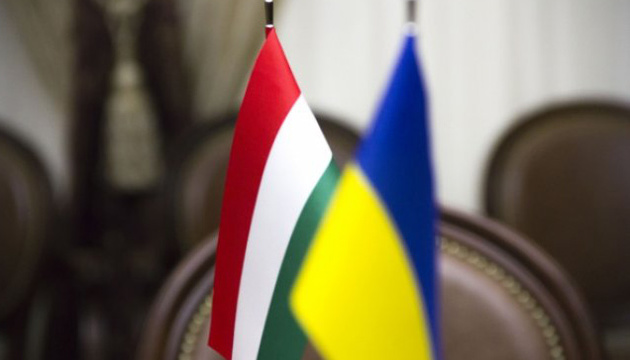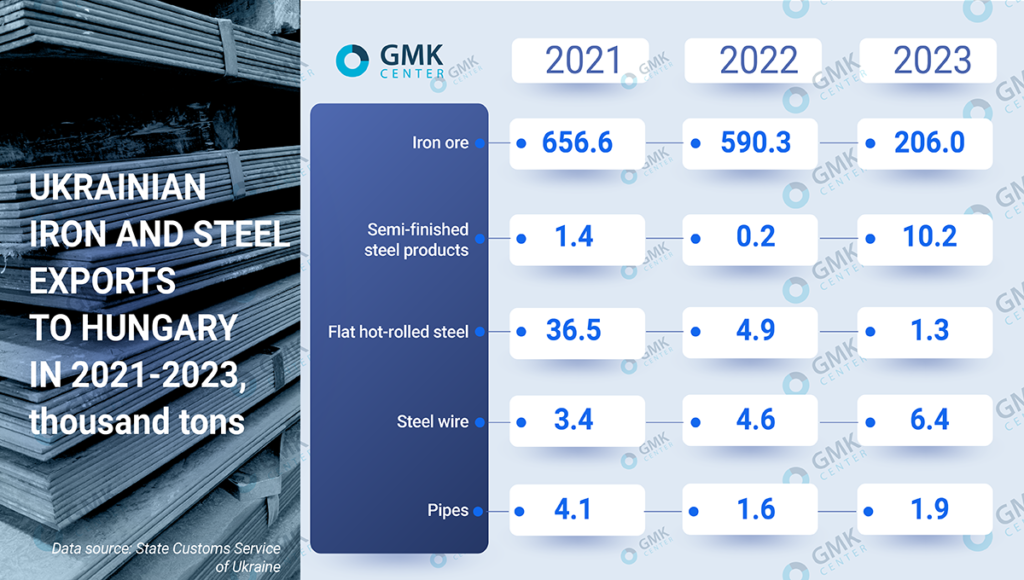Doing business

After the beginning of the Russian military aggression, Hungary became a large and territorially close market for Ukrainian agricultural products (until mid-2023), a transit country for exports, and a supplier of energy resources that have become critical for Ukraine and its economy. Perhaps, for the current situation, the economic factor of cooperation is more important than the lack of political support for Ukraine.
Foreign trade statistics between the countries show multidirectional trends. In 2022, Ukrainian exports in monetary terms increased by 40% y/y – to $2.3 bln, but in 2023 it fell by 48% y/y – the reason for this lies in the European Commission’s ban on imports of Ukrainian agricultural products (from May to September 2023) to five neighboring countries, including Hungary. Last September, Hungary, together with other countries, introduced a unilateral ban and even expanded the list of agricultural products included in it.
The largest items of Ukrainian exports in 2023 were electric heaters ($252 million), corn ($174 million), oil cake ($67 million), wires and cables ($63 million), telephones ($59 million) and wood products ($41 million). There are also insignificant supplies of various industrial raw materials, agro and food products, and consumer goods.

In turn, imports of products from Hungary in monetary terms fell by 47% y/y in 2022 to $1.3 bln, but recovered by 27% y/y the following year – to $1.3 bln, but recovered by 27% y/y in the following year to $1.6 bln – the largest import items from Hungary are gas ($264 million), automobiles ($170 million), petroleum products ($166 million), wire and cable ($148 million), medicines ($53 million), and animal feed ($42 million). Supplies of gas and petroleum products from Hungary are extremely important for Ukraine, in particular, to ensure fuel and safe operation of the energy system, especially amid Russian strikes on the energy infrastructure. Ukraine also imported agro-products, foodstuffs, plastic products, a variety of industrial raw materials and consumer goods.
In 2023, Ukrainian exports exceeded imports from Hungary in physical terms by 2.7 times, but in monetary terms were less by 21%. This ratio indicates that Ukraine supplies a significant portion of raw materials, while importing higher value-added products.
The situation with logistical constraints on the part of Hungary looks much better than, for example, with Poland. Hungarian farmers and transporters staged protests at the border, but did not block truck traffic. This partially alleviated the overall situation: under the conditions of blockade of the Polish section of the border, trucks with Ukrainian exports and imports went through the territory of Hungary, Romania and Slovakia.
Due to the loss of capacity and reduction in domestic production, Ukrainian exports of iron and steel products in 2023 compared to 2021 to this country decreased by 68% to 229 thousand tons, in monetary terms – by 72%, to $36 million.

Iron ore, the most popular item in Ukrainian steel exports, also prevails in the structure of supplies to Hungary. However, Ukrainian exports are declining due to lower demand in this country. Last year iron ore exports from Ukraine to Hungary fell to 206,000 tons from 657,000 tons in pre-war 2021. Over the same period, export revenues fell from $18m to $79m.
Prospects for Ukrainian iron ore exports depend on the level of utilization of steel capacities in Hungary. There are opportunities for a significant increase in steelmaking in Hungary and growth in consumption of Ukrainian iron ore, but the probability of a favorable scenario is not very high.

The key positions of steel products exported from Ukraine to the Hungarian market are flat hot-rolled products and semi-finished steel products. Under the conditions of the war, supplies of hot-rolled steel products have practically ceased (due to a decrease in domestic production), but semi-finished products, on the contrary, have increased. There are also deliveries of steel wire and pipes, which look insignificant both in terms of the level of Ukrainian production and the size of the Hungarian market.
The prospects for Ukrainian steel products on the Hungarian market are extremely uncertain. Hungary has a rather low level of metal consumption (2.6 mln tons in 2022), and Ukrainian producers are now unable to meet even domestic demand for finished steel products. Therefore, it is doubtful that Hungary will become a major export market for Ukrainian steel products in the foreseeable future.
The Hungarian steel industry is in severe stagnation. According to Worldsteel, in 2022 steel production in the country will fall by 22% y/y – to 857 thousand tons, in 2023 – by another 44.3% y/y – to 477 thousand tons.
The problems of the Hungarian steel industry are related to the situation around Dunaferr, the country’s largest steelmaker. The steel mill faced lack of effective management, shortage of working capital and investments. This resulted in periodic downtime, which led to the launch of the liquidation process and the announcement of a tender for the acquisition of Dunaferr. Following a final bidding process in July 2023, in which there were only two bidders, UK-based Liberty Steel won with a bid of €55 million.
Ukraine’s Metinvest also applied to participate in the tender, but the company was rejected for extremely dubious reasons. In general, the whole tender was extremely non-transparent. The Hungarian government transferred Dunaferr to the management of Liberty Steel back in the winter of 2023, without public tenders. After the tender was announced and the guarantee fee was determined, given its size, the expected value of Dunaferr should have been €200 mln. But after Metinvest was excluded from the tender, the Hungarian government put the price at around €50 mln.
«Considering these factors, it can be assumed that the tender from the beginning was designed by the Hungarian government as a mechanism to legalize the transfer of the plant at a non-market value to a specific buyer – Liberty Steel. In our opinion, given the non-compliance of the conducted auction with transparency criteria, the EU antimonopoly authorities should pay attention to the actions of the Hungarian government during the tender for the plant and make their decision», Metinvest said in a statement.
The new owner was unable to quickly restore the mill’s operations. In August-September 2023, Liberty Steel shut down the only blast furnace and rolling lines at Dunaferr. This was attributed to high production costs, low finished product prices and slab shortages. In total, the plant has the capacity to produce two million tons of rolled products in a year.
The general decline is also affecting the country’s steel exports. Compared to the pre-war 2021 Hungarian exports of iron and steel products to Ukraine in 2023 decreased by more than 80% – from 23.6 thousand tons to 4.1 thousand tons. Export revenue for the same period decreased to $4.3 mln.
The most significant items of Hungarian exports are coke and coated rolled products. From pre-war 13.2 thousand tons and 9.4 thousand tons respectively, their shipments fell below two thousand tons in 2023. Due to the size of shipments, the importance of Hungarian steel products for the Ukrainian market is now minimal, although it may increase for the purposes of the country’s post-war reconstruction if Dunaferr works more steadily.
Although Dunaferr has launched rolling mills and a galvanizing line this year, the overall prospects of the company are not clear. Liberty Steel can be considered a very mediocre owner, and the European steel market has been shaken by low demand and prices for finished products, as well as high energy prices for the last few years.
A limitation for the development of trade and transit between Ukraine and Hungary is the low capacity of transport crossings. There are only three of them: for rail freight transportation – “Batevo-Epereshke” (capacity – 420 railcars) and “Chop-Zakhon” (30 railcars) and only one for trucks – “Chop-Zakhon”. This point can allow up to 250 trucks to leave Ukraine per day.
Since the beginning of the war, Hungary has shown only theoretical interest in expanding the border transportation infrastructure. Only recently our countries have agreed to expand road and railroad crossings in Bereghshuran and Zakhon and to build a new bridge across the Tisza. There is also an agreement to open the road crossing «Luzhanka – Bereghshuran» for the movement of empty trucks and vans up to 7.5 tons and to create a new road crossing «Dijda – Beregdarots». There are opportunities and necessity for expansion, according to the Ministry of Infrastructure, only 10% of cargo traffic from Ukraine passes through Hungary due to insufficient capacity.
Trade relations between Ukraine and Hungary go largely on their own, without regard to the political context. Otherwise, Ukrainian-Hungarian relations are very cool and strained. No significant preconditions for their warming are visible in the foreseeable future.
Source https://gmk.center/ua/